Abstract
The enzyme activity of the rat hindgut microflora maintained in an anaerobic two-stage continuous culture was compared with that of rat cecal contents. A qualitative comparison (API ZYM) showed a high degree of similarity between the two populations. Quantitative determinations showed that azoreductase, beta-glucosidase, nitrate reductase, and nitroreductase activities were comparable, and that beta-glucuronidase activity was very low in the culture. beta-Glucuronidase, beta-glucosidase, and nitrate reductase activities were induced within the culture by their respective substrates. Bile acids influenced microbial activity in vitro, with cholic acid inducing beta-glucosidase, azoreductase, and beta-glucuronidase activities and decreasing nitrate reductase activity. Chenodeoxycholic acid increased beta-glucosidase and beta-glucuronidase activities and decreased azoreductase, nitrate reductase, and nitroreductase activities in vitro. These studies demonstrate that the rat hindgut microflora may be successfully cultured in vitro and suggest control mechanisms that regulate the metabolic activity of these organisms in vivo.
Full text
PDF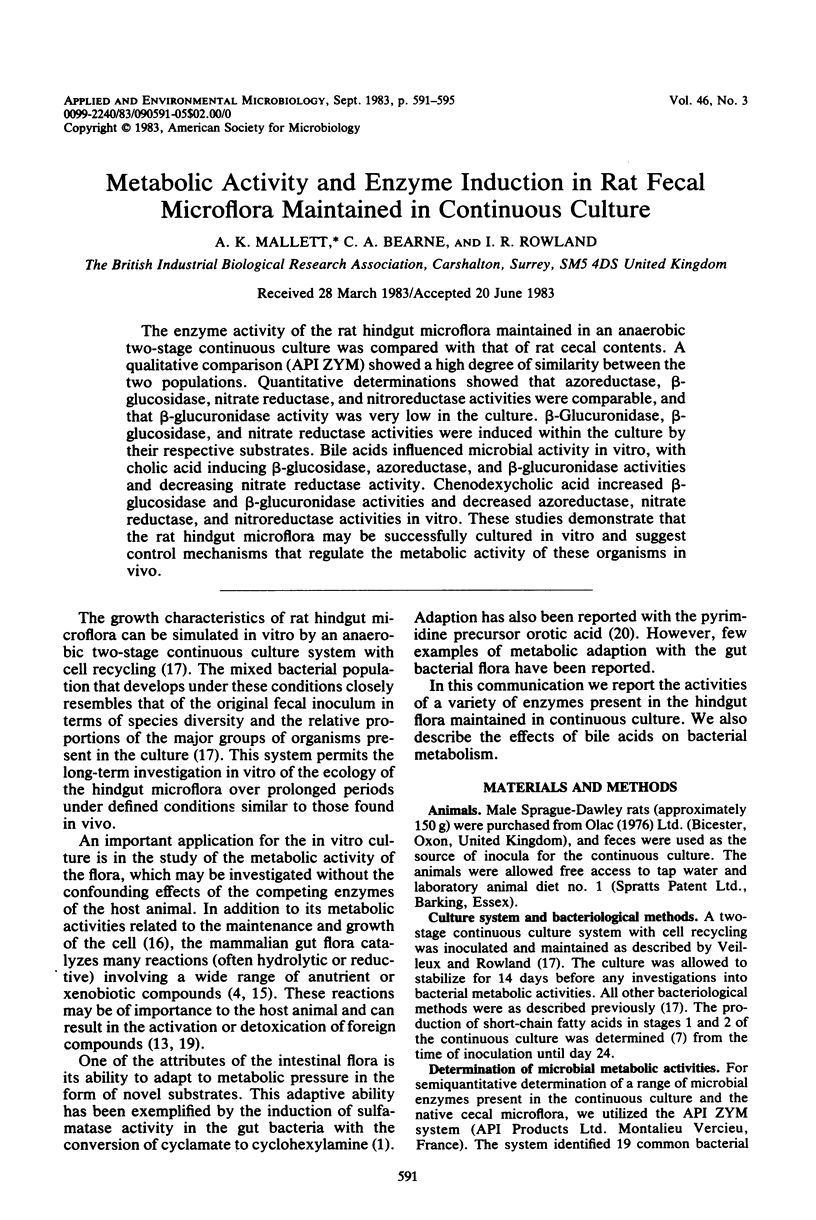
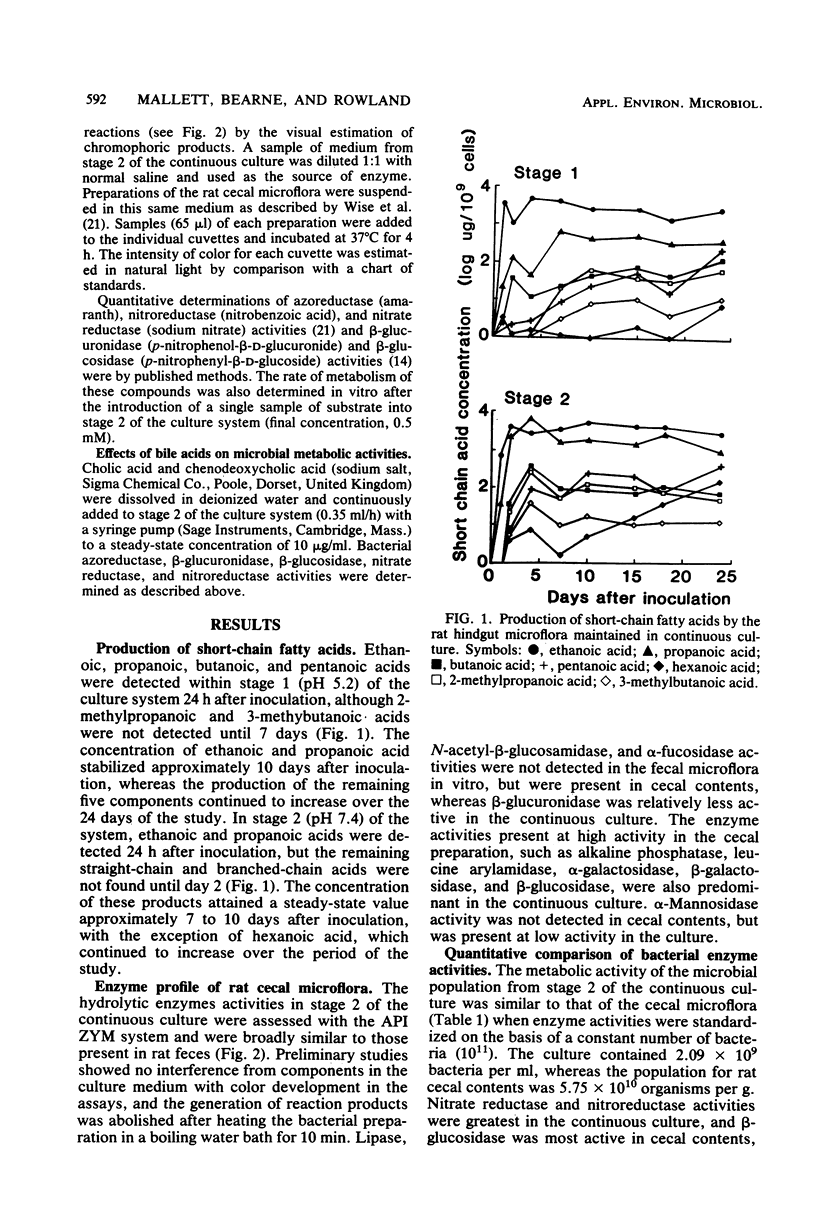
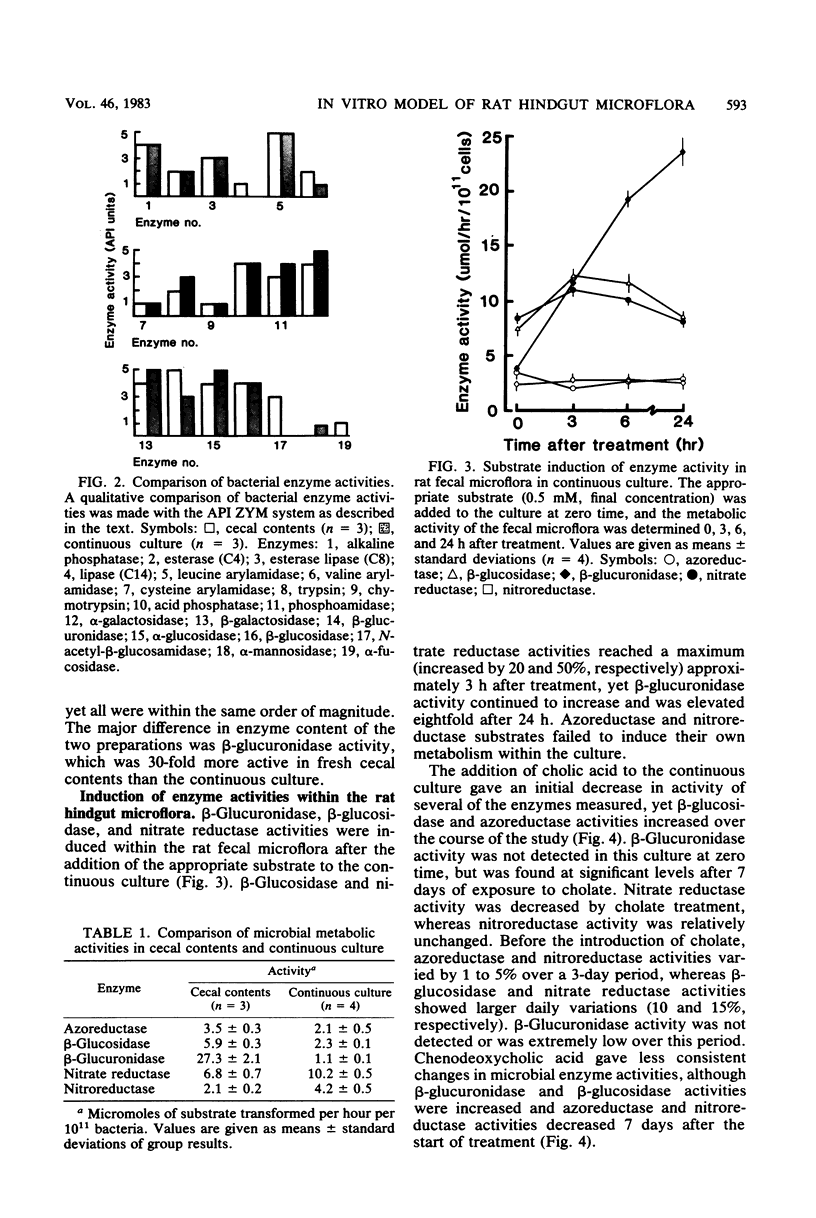
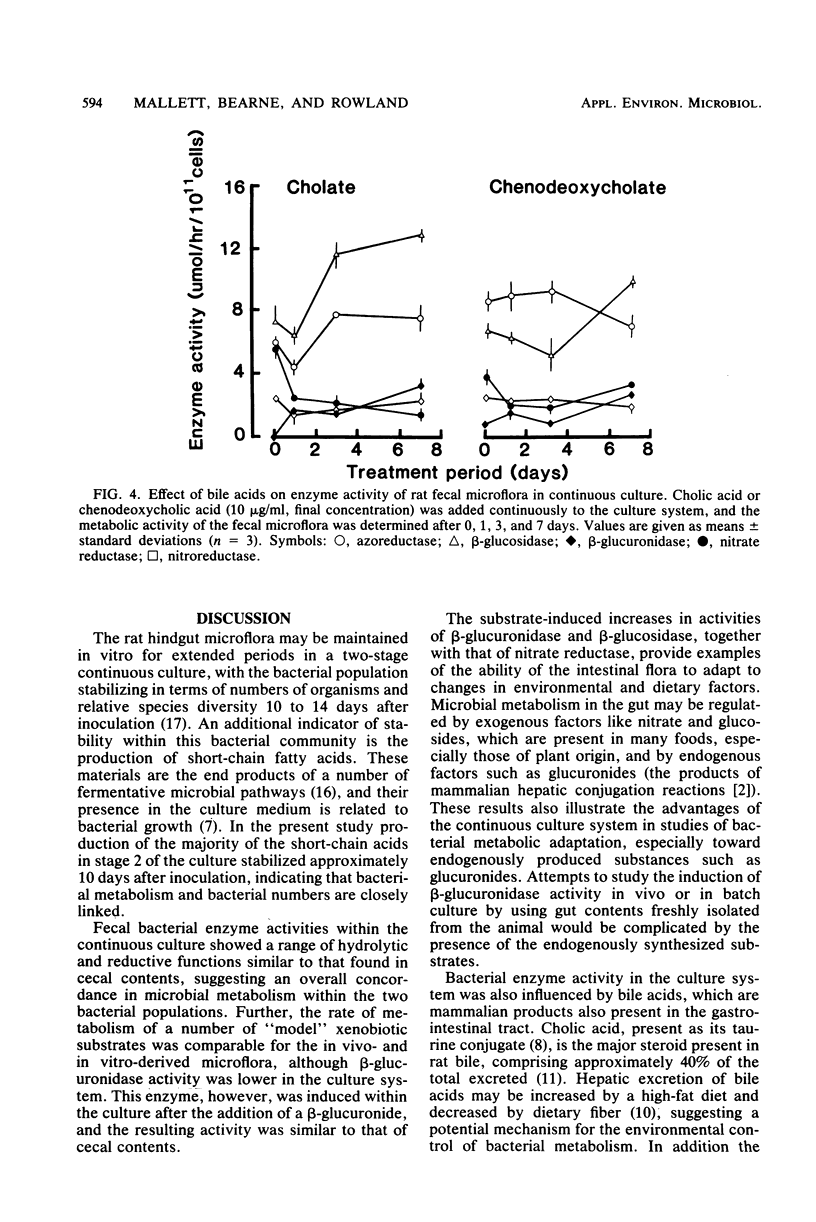
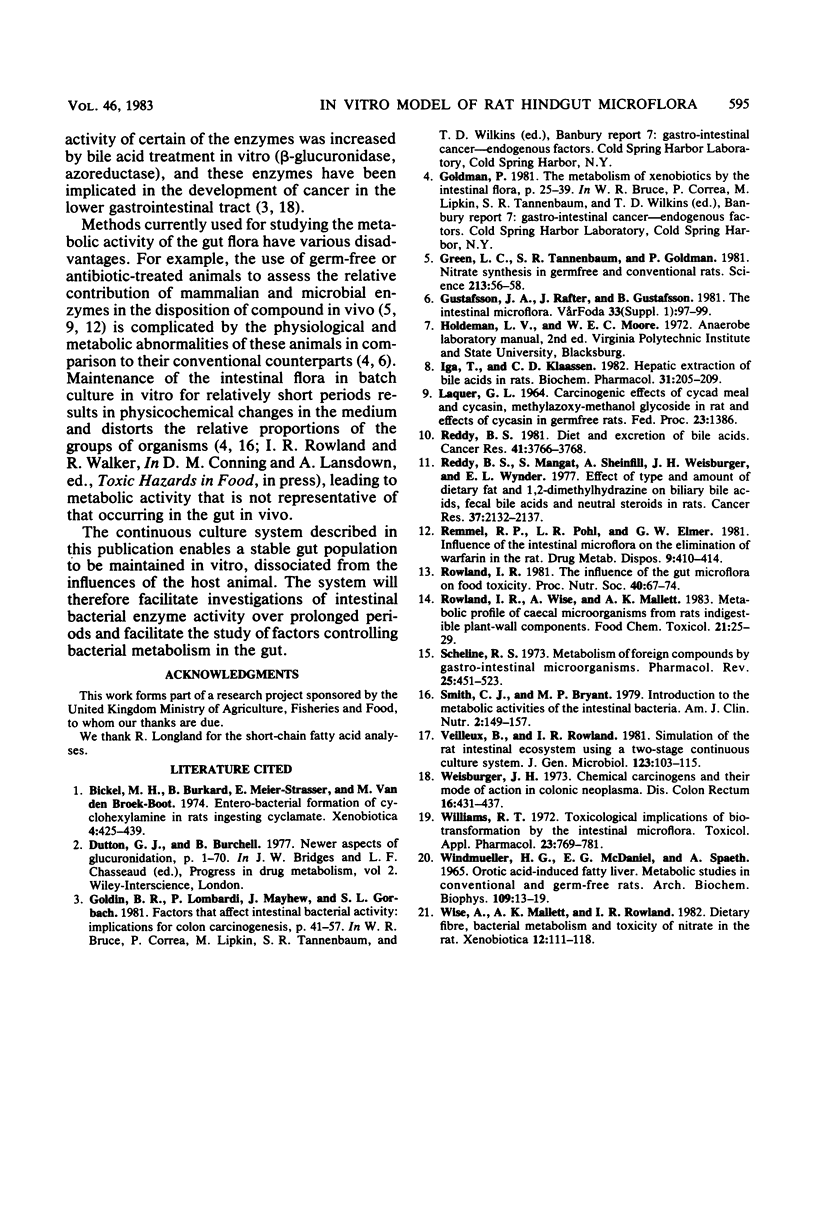
Selected References
These references are in PubMed. This may not be the complete list of references from this article.
- Bickel M. H., Burkard B., Meier-Strasser E., van den Broek-Boot M. Entero-bacterial formation of cyclohexylamine in rats ingesting cyclamate. Xenobiotica. 1974 Jul;4(7):425–439. doi: 10.3109/00498257409052106. [DOI] [PubMed] [Google Scholar]
- Green L. C., Tannenbaum S. R., Goldman P. Nitrate synthesis in the germfree and conventional rat. Science. 1981 Apr 3;212(4490):56–58. doi: 10.1126/science.6451927. [DOI] [PubMed] [Google Scholar]
- Iga T., Klaassen C. D. Hepatic extraction of bile acids in rats. Biochem Pharmacol. 1982 Jan 15;31(2):205–209. [PubMed] [Google Scholar]
- LAQUEUR G. L. CARCINOGENIC EFFECTS OF CYCAD MEAL AND CYCASIN, METHYLAZOXYMETHANOL GLYCOSIDE, IN RATS AND EFFECTS OF CYCASIN IN GERMFREE RATS. Fed Proc. 1964 Nov-Dec;23:1386–1388. [PubMed] [Google Scholar]
- Reddy B. S. Diet and excretion of bile acids. Cancer Res. 1981 Sep;41(9 Pt 2):3766–3768. [PubMed] [Google Scholar]
- Reddy B. S., Mangat S., Sheinfil A., Weisburger J. H., Wynder E. L. Effect of type and amount of dietary fat and 1,2-dimethylhydrazine on biliary bile acids, fecal bile acids, and neutral sterols in rats. Cancer Res. 1977 Jul;37(7 Pt 1):2132–2137. [PubMed] [Google Scholar]
- Remmel R. P., Pohl L. R., Elmer G. W. Influence of the intestinal microflora on the elimination of warfarin in the rat. Drug Metab Dispos. 1981 Sep-Oct;9(5):410–414. [PubMed] [Google Scholar]
- Rowland I. R., Wise A., Mallett A. K. Metabolic profile of caecal micro-organisms from rats fed indigestible plant cell-wall components. Food Chem Toxicol. 1983 Feb;21(1):25–29. doi: 10.1016/0278-6915(83)90264-8. [DOI] [PubMed] [Google Scholar]
- Rowland I. The influence of the gut microflora on food toxicity. Proc Nutr Soc. 1981 Jan;40(1):67–74. doi: 10.1079/pns19810011. [DOI] [PubMed] [Google Scholar]
- Scheline R. R. Metabolism of foreign compounds by gastrointestinal microorganisms. Pharmacol Rev. 1973 Dec;25(4):451–523. [PubMed] [Google Scholar]
- Smith C. J., Bryant M. P. Introduction to metabolic activities of intestinal bacteria. Am J Clin Nutr. 1979 Jan;32(1):149–157. doi: 10.1093/ajcn/32.1.149. [DOI] [PubMed] [Google Scholar]
- Veilleux B. G., Rowland I. Simulation of the rat intestinal ecosystem using a two-stage continuous culture system. J Gen Microbiol. 1981 Mar;123(1):103–115. doi: 10.1099/00221287-123-1-103. [DOI] [PubMed] [Google Scholar]
- WINDMUELLER H. G., MCDANIEL E. G., SPAETH A. OROTIC ACID-INDUCED FATTY LIVER. METABOLIC STUDIES IN CONVENTIONAL AND GERM-FREE RATS. Arch Biochem Biophys. 1965 Jan;109:13–19. doi: 10.1016/0003-9861(65)90280-8. [DOI] [PubMed] [Google Scholar]
- Weisburger J. H. Chemical carcinogens and their mode of action in colonic neoplasia. Dis Colon Rectum. 1973 Nov-Dec;16(6):431–437. doi: 10.1007/BF02588865. [DOI] [PubMed] [Google Scholar]
- Williams R. T. Toxicologic implications of biotransformation by intestinal microflora. Toxicol Appl Pharmacol. 1972 Dec;23(4):769–781. doi: 10.1016/0041-008x(72)90118-4. [DOI] [PubMed] [Google Scholar]
- Wise A., Mallett A. K., Rowland I. R. Dietary fibre, bacterial metabolism and toxicity of nitrate in the rat. Xenobiotica. 1982 Feb;12(2):111–118. doi: 10.3109/00498258209046784. [DOI] [PubMed] [Google Scholar]


